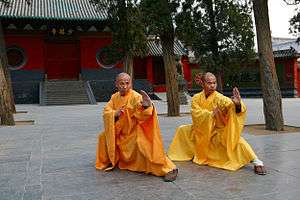Wu Ta-ch'i
Wu Ta-ch'i or Wu Daqi (1926–1993) was the descendant of the famous Wu-style t'ai chi ch'uan founders Wu Ch'uan-yu (1834–1902) and Wu Chien-ch'uan (1870–1942). He directed Wu-style t'ai chi ch'uan instruction outside of Mainland China after the death of his father Wu Kung-i (1900–1970) and brother Wu Ta-kuei (1923–1972) from the Wu-style t'ai chi ch'uan headquarters in Hong Kong internationally.[1]
| 吴大齐 Wu Ta-ch'i | |
|---|---|
| Born | 1926 China |
| Died | 1993 (aged 66–67) |
| Nationality | Chinese |
| Style | Wu-style taijiquan |
| Notable students | Chu Weng-Moon |
| Wu Ta-ch'i | |||||||
|---|---|---|---|---|---|---|---|
| Traditional Chinese | 吳大齊 | ||||||
| Simplified Chinese | 吴大齐 | ||||||
| |||||||
| Part of a series on |
| Chinese martial arts (Wushu) |
|---|
 |
| Wushu in the world |
|
Historical locations
|
| Wushu athletes/practitioners |
|
Legendary figures
|
|
Historical individuals
|
|
Modern celebrities
|
| Wushu influence |
Biography
Born in China to a distinguished martial arts family, Wu Ta-ch'i, with his brother Wu Ta-kuei, sister Wu Yen-hsia as well as his first cousin Wu Ta-hsin all endured strict training from their nationally famous grandfather and father.[2] Being the grandchildren of the family, they were traditionally expected to inherit the family art of t'ai chi ch'uan whom their great-grandfather Wu Ch'uan-yu had first learned from Yang Luchan (1799–1872) and his son Yang Pan-hou (1837–1890).[3]
When Wu Kung-i migrated with his family to Hong Kong in the 1940s, Wu Ta-ch'i assisted his father in the propagation and teaching of t'ai chi ch'uan. During the 1950s under the instructions of Wu Kung-i, Wu Ta-ch'i and his cousin Wu Ta-hsin (1933–2005) travelled extensively to Malaysia and Singapore to start and support academies promoting Wu-style t'ai chi.[2] Their efforts met with success, making the region a key centre of Wu-style t'ai chi ch'uan outside of Hong Kong and China.[2] Wu Ta-ch'i's chief disciple Chu Weng-Moon in Malaysia and his fellow disciples continue to teach Wu-style t'ai chi ch'uan.
In 1974, Wu Ta-ch'i was invited by the Chinese Canadian Kuo Shu Federation to teach in Toronto,Ontario, Canada where he established the first Wu family school outside of Asia.[2] The Canadian school founded by Wu Ta-ch'i was entrusted to his nephew Wu Kuang-yu (Eddie) in 1976.[4]
Wu Ta-ch'i was a member of the advisory board of the Martial Art Association in Hong Kong.
References
- Cai, Naibiao (2006). "In Memory of Wu Daxin - Journal of Asian Martial Arts Vol. 15 No. 1". Via Media Publishing, Erie Pennsylvania USA. ISSN 1057-8358. Cite journal requires
|journal=(help) - Yip, Y. L. (Autumn 2002). "Pivot". Qi: The Journal of Traditional Eastern Health and Fitness. Insight Graphics Publishers. 12 (3). ISSN 1056-4004.
- Wile, Douglas (1995). Lost T'ai-chi Classics from the Late Ch'ing Dynasty (Chinese Philosophy and Culture). State University of New York Press. ISBN 978-0-7914-2654-8.
- Philip-Simpson, Margaret (June 1995). "A Look at Wu Style Teaching Methods - T'AI CHI The International Magazine of T'ai Chi Ch'uan Vol. 19 No. 3". Wayfarer Publications. ISSN 0730-1049. Cite journal requires
|journal=(help)
External links
- http://www.wustyle.com/ International Wu Style Tai Chi Chuan Federation website
- http://www.wustyledetroit.com/ Detroit, Michigan Wu style website